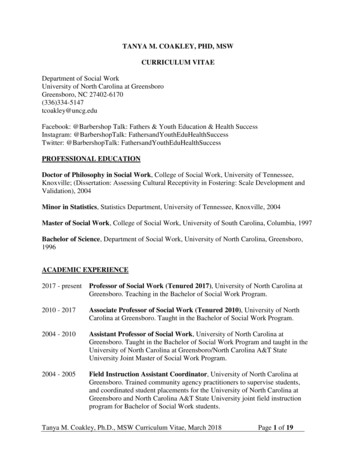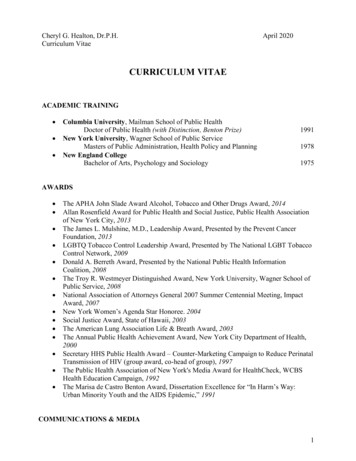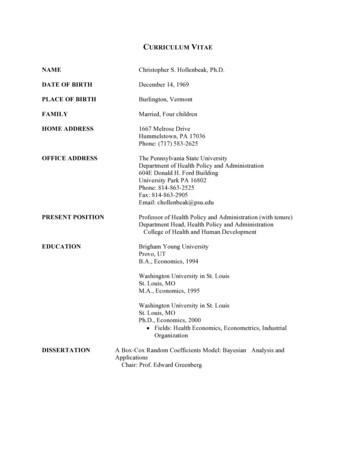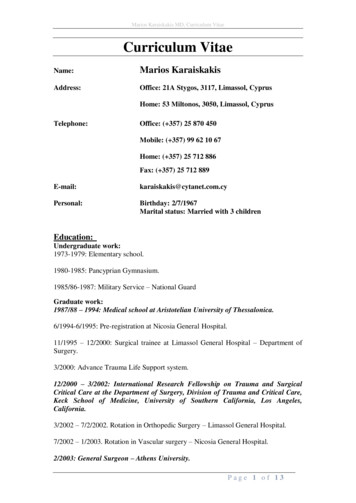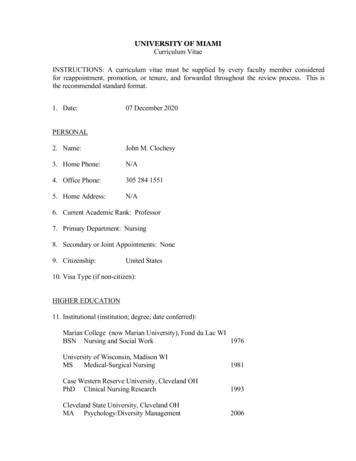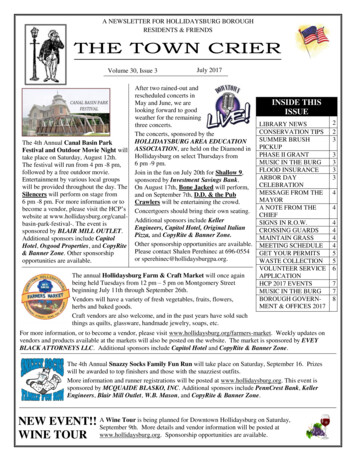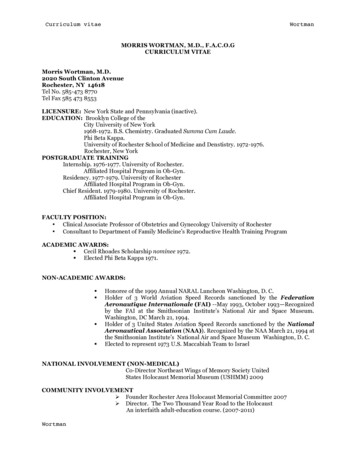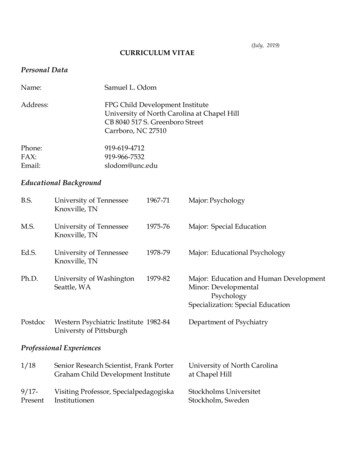
Transcription
(July, 2019)CURRICULUM VITAEPersonal DataName:Samuel L. OdomAddress:FPG Child Development InstituteUniversity of North Carolina at Chapel HillCB 8040 517 S. Greenboro StreetCarrboro, NC m@unc.eduEducational BackgroundB.S.University of TennesseeKnoxville, TN1967-71Major: PsychologyM.S.University of TennesseeKnoxville, TN1975-76Major: Special EducationEd.S.University of TennesseeKnoxville, TN1978-79Major: Educational PsychologyPh.D.University of WashingtonSeattle, WA1979-82Major: Education and Human DevelopmentMinor: DevelopmentalPsychologySpecialization: Special EducationPostdocWestern Psychiatric Institute 1982-84Universty of PittsburghDepartment of PsychiatryProfessional Experiences1/18Senior Research Scientist, Frank PorterGraham Child Development InstituteUniversity of North Carolinaat Chapel Hill9/17PresentVisiting Professor, SpecialpedagogiskaInstitutionenStockholms UniversitetStockholm, Sweden
Samuel L. OdomPage 28/0612/17Director, Frank Porter GrahamChild Development InstituteUniversity of North Carolinaat Chapel Hill8/0609/17Professor, School of EducationUniversity of North Carolinaat Chapel Hill1/99 to8/06Edward and Mary Lou Otting Professor Indiana UniversitySpecial Education ProgramBloomington, IN9/96-12/98 William C. Friday DistinguishedProfessor of Child Developmentand Family StudiesUniversity of North Carolinaat Chapel Hill9/94-8/96Peabody College ofVanderbilt UniversityProfessor of SpecialEducation10/92-8/96 Co-Director, Instituteon Prevention, EarlyIntervention and FamiliesJohn F. Kennedy CenterPeabody College ofVanderbilt University5/89 - 8/94 Associate Professorof Special EducationPeabody College ofVanderbilt University9/86 - 5/89 Assistant Professorof Special EducationPeabody College ofVanderbilt University9/84 - 8/86 Coordinator, Preschool/Elementary Autism TrainingProgramDevelopmental Training CenterIndiana UniversityBloomington, IN6/81 - 10/82 Coordinator, IntegratedPreschool ProjectCo-Principal Investigator(1982)Experimental Education UnitUniversity of WashingtonSeattle, WA9/77 - 6/79 Preschool Special EducationTeacherKnoxville Adaptive EducationCenter, Knoxville, TN1/77 - 6/77 Itinerant ResourceTeacherCocke County Board of EducationNewport, TN
Samuel L. OdomPage 3
Samuel L. OdomPage 4Honors Honorary Doctoral Degree, Stockholm University, Stockholm, Sweden, 2016 Arnold Lucius Gesell Prize awarded for career achievement in research on social inclusion andchild development by the Theordor Hellbrugge Foundation, Munich, Germany, 2013. University of Washington College of Education Outstanding Graduate Award, 2011. Outstanding Special Education Research Award, Council for Exceptional Children, 2007. Fellow, Poynter Center for the Study of Ethics in American Institutions, Indiana University,2004-2005 Service to the Field Award, Division of Early Childhood, Council for Exceptional Children, 2001 Outstanding Research Award, Special Education SIG, American Educational ResearchAssociation, 1999 Edward and Marylou Otting Professorship in Special Education, Indiana University (19992006). Merle B. Karnes Award for Service to the Division, Division for Early Childhood, Council forExceptional Children, 1994. William C. Friday Endowed Professorship in Child Development and Family Studies,University of North Carolina, 1996-1999, Faculty Teaching Award, Department of Special Education, Peabody College, VanderbiltUniversity, 1988. National AAMD Student Service Award, 1982. Gordon Lee Outstanding Dissertation Award, College of Education, University of Washington,1982-83. Doctoral Fellow, Area of Special Education, University of Washington,1979-80, 1980-81.Grant ActivitiesHume, K. A., & Odom, S. L. (Co-PIs) (2018-2020). Efficacy Follow-up Study of the CSESA Model.Institute of Education Sciences, Goal 3 Efficacy Followup. Total Award 1, 100,00.Odom, S. L., Cox, A. & Sam, A. (2017-2020). Supporting Paraprofessionals’ Use of Evidence-basedPractices for Students with Autism Spectrum Sisorders. Institute of Education Sciences, Goal 2Development Project. Total Award 1,399,998.Odom, S. L., Hume, K. A., & Boyd, B. (2016-2020). Postdoctoral research in autism and specialeducation research. Institute of Education Sciences. Total Award 693,415Odom, S. L. & Cox, A. (2015-2020). Efficacy study of the school-based National ProfessionalDevelopment Center on ASD model. Institute on Education Sciences, Goal 3 Efficacy Study.Total Award 3,498, 535.
Samuel L. OdomPage 5Odom, S. L. (Principal Investigator), Cox, A, & Sam, A. (2014-2016). Project AFIRM: Design moduleson evidence based practice for students with autism spectrum disorder. Two year grant fromOffice of Special Education through subcontract from IRIS Center. Total Award 400,000.Odom, S. L., (Principal Investigator), Hume, K., Boyd, B., Lane, K., Duda, M., Seltzer, M., Smith, L.,Carter, E., Vaughn, S., Browder, D., & Test, D. (Investigators) (2012-2018). Center on SecondaryEducation for Students with Autism Spectrum Disorders (CSESA). Goal 2 Institute of EducationSciences, Research and Development Center. Total Award 10,000,000.Schertz, H. (Principal Investigator), Odom, S. L., & Baggett, K. (2012-2016). Joint Attention MediatedLearning Intervention for Toddlers with Autism Spectrum Disorders and Their Families.Institute of Education Science, Goal 3 Efficacy study. Total Subcontract Award 1,101,953.Odom, S. L. (Principal Investigator), and Cox, A. (2012-2013). The Toddler Initiative: Promoting theUse of Evidence-based Practices for Toddlers with Autism Spectrum Disorders and theirFamilies in Early Intervention Programs. Funded by Autism Speaks. (Total Award 400,000).Odom, S. L., & Cox, A. (2011-13). Autism Professional Development Center in Saudi Arabia.Collaborative agreement with the King Faisal Specialized Hospital and Research Center.Riyadh, Saudi Arabia. Total Award 189,770.Odom, S. L. (2011-2012). BeActive Kids North Carolina. Blue Cross/Blue Shield Foundation. TotalAward 184,623.Odom, S. L. (2009-2012). Evaluation of Special Olympics Young Athlete’s Program. Special Olympics.(Total Award 247,153)Odom, S. L. (Principal Investigator). (2009-2013). Postdoctoral training program in special educationresearch. Institute of Education Science. Total Award 638,279.Odom, S. L. (Principal Investigator) and Boyd, B. (Co-Principal Investigator). (2007-2011).Comparison of Two Treatment Models for Preschool-aged Children with Autism and TheirFamilies. Institute of Education Sciences, Goal 3 Efficacy Study. Total Award 3,019,247.Schertz, H., Odom, S. (Co-PI), & Badgett, K. (2007-2010). Promoting Early Social-communicativeCompetency in Toddlers with Autism. Autism Speaks. University of Northern Colorado withsubcontract to the University of North Carolina at Chapel Hill. Total Subcontact to UNC 250,000
Samuel L. OdomPage 6Odom, S. L. (Principal Investigator). (2007-2012). Professional Development Center: Children withAutism Spectrum Disorder. Department of Education, Office of Special Education Programs.Total Budget 5,000,000Odom, S. L. (Principal Investigator). (2003-2008). Children’s School Success. National Institute forChild Health and Human Development. Total Award 4,460,000.Odom, S. L. (Principal Investigator). (2002-2003). Connecting with Communities on Behalf ofChildren’s School Success: A Planning Grant for an Experimental Study. National Institute onChildren’s Health and Human Development. Total Award 186,250Odom, S. L. (Principal Investigator) and David Mank (Co-Principal Investigator). (2002-2006). IndianaUniversity Leadership Training Program in Special Education. Submitted to the Office ofSpecial Education Programs. Total Award 713,807.Odom, S. L. (Principal Investigator), and Virginia Buysse. (2001-2004). Cost, Quality, and Outcomes ofPreschool Inclusion. Field-initiated Research Project, Office of Special Education Programs.Total award 540,000.Odom, S.L. (Principal Investigator) and Bailey, D.B. (1997-2001). Interdisciplinary Doctoral Training inEarly Childhood, Families and Early Intervention. Four year leadership training grant fundedby the Office of Special Education Programs. 1997-98 224,809.Odom, S.L. (Principal Investigator). (1994-99, no cost extension, 1999-2000). Early Childhood ResearchInstitute on Inclusion. Five year, multisite research institute funded by the Office of SpecialEducation Programs. Total Award 4,641,000Odom, S. L., & Brown, W. H. (Co-Principal Investigators). (1993-95). Observational Assessment ofSocial Goals and Strategies of Young Children with Disabilities and their Peers. Eighteen monthproject funded by the Office of Special Education. 1993-1995 75,000.Odom, S. L., Brown, W. H., & Horn, E. (Co-Principal Investigators). (1991-96). Project BLEND:Beginning Learning Experiences in Developmentally Integrated Groups and Homes. Five yearproject funded by the Office of Special Education and Rehabilitation. Total Award 600,000.Horn, E. A., & Odom, S. L. (Co-Principal Investigator). (1992-96). Training of Early Childhood andPreschool Personnel. Four year project funded by the Office of Special Education. Total Award 425,000.Odom, S. L. (Principal Investigator). (1990-93). Peabody Developmental Intervention Model forTechnology-Dependent/Chronically Ill Infants. Three year project funded by the Bureau of
Samuel L. OdomPage 7Maternal and Child Health, Department of Health and Human Services. Total Award 298,402.Odom, S. L. (Co-Principal Investigator) & Wolraich, M. (Co-Principal Investigator). (1990-95). ProjectSEARCH: Tennessee Early Intervention System. Series of one year grants funded by theTennessee State Department of Education. 1994-95 475,335.Odom, S. L. (Principal Investigator). (1990-91). Development of a Taxonomy of Early Intervention forInfants with Disabilities and their Families. Pilot project funded by Vanderbilt UniversityFaculty Research Council. Total award 3,810.Odom, S. L. (Principal Investigator). (1989-92). Training of Personnel for the Education of theHandicapped: Early Childhood. Three year project funded by the Office of Special Educationand Rehabilitation, Department of Education. Total award 237,390.Chandler, L. (Co-Principal Investigator) & Odom, S. L. (Co-Principal Investigator). (1989). FamilyAdaptations to the Transition to Parenthood of Technology-Dependent Infants from Hospital toHome. Pilot project funded by the Joseph Kennedy Foundation. Total award 5,700.Sheehan, R. J. (Principal Investigator) & Odom, S. L. (Co-Principal Investigator). (1988-89). A Proposalto Evaluate Direct Service Projects Operating in Indiana in Support of P.L. 99-457. Eighteenmonth project funded through Cleveland State University by the Indiana Department of MentalHealth. Total award 45,157.Odom, S. L. (Principal Investigator) & McConnell, S. R. (Co-Principal Investigator). (1987-91). SocialInteraction Training Programs for Young Children with Handicaps: Analysis of ProgramFeatures. Four year grant funded by the Office of Special Education and Rehabilitation, No.G008730527. Total award 1,211,331.Publications: Peer-reviewed ArticlesOdom, S. L. (1981). The relationship of play to developmental level in mentally retarded preschoolchildren. Education and Training of the Mentally Retarded, 16, 136-141.Odom, S.L. & Speltz, M.L. (1983). Program variations in preschools for handicapped andnonhandicapped children: Mainstreamed vs. integrated special education. Analysis andIntervention in Developmental Disabilities, 3, 89-103.Strain, P. S., Breuning, S., Cordisco, L., Goldstein, H., Lyon, S., Odom, S. L., & Sainato, D. (1983). Anoverview of the early childhood research institute. Journal for the Division for Early Childhood, 7,25-31.
Samuel L. OdomPage 8Odom, S. L., & Fewell, R. F. (1983). Program evaluation in early childhood special education: Ameta-evaluation. Educational Evaluation and Policy Analysis, 5, 445-460.Strain, P. S., Odom, S. L., & McConnell, S. (1984). Promoting social reciprocity of handicappedchildren: Identification, target behavior selection, and intervention. Remedial and SpecialEducation, 5, 21- 29.Odom, S. L., DeKlyen, M., & Jenkins, J. R. (1984). Integrating handicapped and nonhandicappedpreschool children: Developmental impact on the nonhandicapped children. ExceptionalChildren, 51, 41-48.Odom, S. L., & Strain, P. S. (1984). Peer-mediated approaches to increasing children’s socialinteractions: A review. American Journal of Orthopsychiatry, 54, 544-557.Odom, S. L., & Strain, P. S. (1984). Classroom-based social skills instruction for severely handicappedpreschool children. Topics in Early Childhood Special Education, 4(3), 97-116.Odom, S. L., & McConnell, S. R. (1985). Performance-based conceptualization of social competence ofhandicapped preschool children: Implications for assessment. Topics in Early Childhood SpecialEducation, 4(4), 1-19.Odom, S. L., Hoyson, M., Jamieson, B., & Strain, P. S. (1985). Increasing handicapped preschoolers’peer social interactions: Cross-setting and component analysis. Journal of Applied BehaviorAnalysis, 18, 3-16.Jenkins, J. R., Speltz, M. L., & Odom, S. L. (1985). Integrating normal and handicapped preschoolers:Effects on child development and social interaction. Exceptional Children, 52, 7-17.Odom, S. L. (1985). Early childhood special education in Germany and the United States: Acomparative view. Journal of the Division for Early Childhood, 9, 215-218.Odom, S. L., Strain, P. S., Karger, M., & Smith, J. (1986). Using single and multiple peers to promotesocial interactions of young children with behavioral handicaps. Journal of the Division for EarlyChildhood, 10, 53-64.Strain, P. S., & Odom, S. L. (1986). Peer social initiations: An effective intervention for social skilldeficits of preschool handicapped children. Exceptional Children, 52, 543-552.
Samuel L. OdomPage 9Odom, S. L., & Strain, P. S. (1986). A comparison of peer-initiation and teacher-antecedentinterventions for promoting reciprocal social interaction of autistic preschoolers. Journal ofApplied Behavior Analysis, 19, 59-72.Odom, S. L., & Shuster, S. K. (1986). Naturalistic inquiry and the assessment of young handicappedchildren and their families. Topic in Early Childhood Special Education, 6(2), 68-82.Odom, S. L. (1987). The role of theory in the preparation of professionals in early childhood specialeducation. Topics in Early Childhood Special Education, 7(3), 1-11.McEvoy, M. A., & Odom, S. L. (1987). Social interaction training for preschool children with behaviordisorders. Behavior Disorders, 12, 242-251.Goldstein, H., Wickstrom, S., Hoyson, M., Jamieson, B., & Odom, S. L. (1988). Effects of script trainingon social and communicative interactions. Education and Treatment of Children, 11, 97-117.Odom, S. L., & Warren, S. F. (1988). Early childhood special education in the Year 2000. Journal of theDivision for Early Childhood, 12, 263-273.Odom, S. L., Yoder, P., & Hill, G. (1988). Developmental interventions for infants with handicaps:Purposes and programs. Journal of Special Education, 22, 11-24.Jenkins, J. R., Odom, S. L., & Speltz, M. L. (1989). Effects of integration and structured play on thedevelopment of handicapped children. Exceptional Children, 55, 420-428.DeKlyen, M., & Odom, S. L. (1989). Structure and preschool peer interactions: Beyond the mainstream.Journal of Early Intervention, 13, 342-352.Odom, S. L., & Chandler, L. (1989). Transition to parenthood for parents of technology assistedinfants. Topics in Early Childhood Special Education, 9(4), 43-55.Odom, S. L., & McEvoy, M. A. (1990). Preschool mainstreaming: Potential barriers and tasks for the field. Topics in Early Childhood Special Education, 10(2), 48-61.Odom, S. L., Peterson, C., McConnell. S. R., & Ostrosky, M. M. (1990). Ecobehavioral analysis of earlyeducation/specialized classroom settings and peer social interaction. Education and Training ofChildren, 13, 316-330.Odom, S. L., & Watts, E. (1991). Reducing teacher prompts in peer-mediated interventions for youngchildren with disabilities. Journal of Special Education, 25, 26-43.
Samuel L. OdomPage 10Lee, S., & Odom, S. L. (1992). The relationship between stereotypic behavior and peer socialinteraction for children with severe disabilities. Journal of the Korean Society for Special Education,8, 1-19. (Published in Korean)Odom, S. L., & McConnell, S. R. (1992). Social competence interventions: An applied behavioranalyses approach. Journal of Applied Behavior Analysis, 25, 239-244.Odom, S. L., Chandler, L. K., Ostrosky, M. M., & McConnell, S. R. (1992). Fading teacher prompts inpeer-initiation interventions for young children with disabilities. Journal of Applied BehaviorAnalyses, 25, 307-317.Odom, S. L., & Ogawa, I. (1992). Direct observation of preschool children’s social interaction: Amethodological review. Behavioral Assessment, ¾, 407-442.McLean, M. E., & Odom, S. L. (1993). Practices for young children with and without disabilities: Acomparison of DEC and NAEYC identified practices. Topics in Early Childhood Special Education,13, 274-293.Odom, S. L., McConnell, S. R., & Chandler, L. K. (1993). Acceptability and feasibility of classroombased social interaction interventions for young children with disabilities. Exceptional Children,60, 226-237.Ostrosky, M. M., Skellenger, A. C., Odom, S. L., McConnell, S. R., & Peterson, C. (1994). Therelationship between teacher schedules and actual time spent in activities in preschool specialeducation classes. Journal of Early Intervention, 18, 25-33.Brown, W. H., & Odom, S. L. (1994). Strategies and tactics for promoting young children’s socialbehavior. Research in Developmental Disabilities, 15, 1-20.Odom, S. L. (1995). Developmentally appropriate practice, policies, and use for young children withdisabilities and their families. Journal of Early Intervention, 18, 346-348.Odom, S. L., McLean, M. E., Johnson, L., & LaMontagne, M. (1995). Recommended practices in EarlyChildhood Special Education: Validation and current use. Journal of Early Intervention, 19, 1-17.Brown, W. H., & Odom, S. L. (1995). Naturalistic peer interventions for promoting preschoolchildren’s social interactions. Preventing School Failure, 39, 38-43.Michnowicz, L.L., McConnell, S.R., Peterson, C.A., & Odom, S.L. (1996). Social goals and objectives ofpreschool IEP: A content analysis. Journal of Early Intervention, 19, 273-282.
Samuel L. OdomPage 11Lee, S., & Odom, S. L. (1996). The relationship between stereotypic behavior and peer socialinteractions for children with severe disabilities. The Journal of the Association for Persons withSevere Handicaps, 21, 88-95. (Previously published in Korean.)Brown, W. H., Odom, S. L., & Holcombe, A. (1996). Observational assessment of young children’ssocial behavior with peers. Early Childhood Research Quarterly, 11, 19-40.Munson, L. J., & Odom, S. L. (1996). Evaluation of rating scales that measure parent-infant interaction.Topics in Early Childhood Special Education, 16, 1-25.Odom, S. L., Peck, C. A., Hanson, M., Beckman, P. J., Kaiser, A. P., Lieber, J., Horn, E. M., Brown, W.H., & Schwartz, I. (1996). Inclusion of preschool children with disabilities: An ecologicalsystems perspective. SRCD Social Policy Report, 10(2-3), 18-30.Favazza, P. C., & Odom, S. L. (1996). Use of the Acceptance Scale to measure attitudes ofkindergarten-age children: A preliminary investigation. Journal of Early Intervention, 20, 232249.Brown, W. H., Horn, E. M., Heiser, J. G., & Odom, S. L. (1996). Project BLEND: An inclusive modelfor early childhood services. Journal of Early Intervention, 20, 364-375.Lieber, J., Beckman, P. J., Hanson, M. J., Janko, S., Marquart, J. M., Horn, E. M., & Odom, S. L. (1997).The impact of changing roles on relationships between professionals in inclusive programs foryoung children. Early Education and Development, 8, 67-83.Favazza, P. C., & Odom, S. L. (1997). Promoting positive attitudes of kindergarten-age childrentoward individuals with disabilities. Exceptional Children, 63, 405-422.Odom, S.L., & Diamond, K.E. (1998). Inclusion of young children with special needs in earlychildhood education: The research base. Early Childhood Research Quarterly, 13, 3-26.Bailey, D. B., Aytch, L. S., Odom, S. L., Symons, F., & Wolery, M. (1999). Early intervention as weknow it. Mental Retardation and Developmental Disabilities Research Reviews, 5, 11-20.McConnell, S. R., & Odom, S. L. (1999). Performance-based assessment of social competence foryoung children with disabilities. Development and initial evaluation of a multi-measure model.Topics in Early Childhood Special Education, 19, 67-74Odom, S. L., McConnell, S. R., McEvoy, M. A., Peterson, C., Ostrosky, M., Chandler, L. K., Spicuzza, R.J., Skellenger, A., Creighton, M., & Favazza, P. C. (1999). Relative effects of interventions for
Samuel L. OdomPage 12supporting the social competence of young children with disabilities. Topics in Early ChildhoodSpecial Education, 19, 75-91.Frea. W., Craig, L., Odom, S.L. & Williams, D. (1999). Differentiated effects of structured socialintegration and group friendship activities for promoting social interactions. Journal of EarlyIntervention, 22, 230-243.Odom, S. L., Horn, E. M., Marquart, J., Hanson, M. J., Wolfberg, P., Beckman, P. J., Lieber, J., Li, S.,Schwartz, I., Janko, S., & Sandall, S. (1999). On the forms of inclusion: Organizational contextand individualized service delivery models. Journal of Early Intervention, 22, 185-199.Brown, W. H., Odom, S. L., Li, S., Zercher, C. (1999). Ecobehavioral assessment in early childhoodprograms: A portrait of preschool inclusion. Journal of Special Education, 33, 138-153.Schwartz, I. S., Odom, S. L., & Sandall, S. R. (1999). Including young children with special needs.Child Care Information Exchange, 130, 74-78.Wolfberg, P., Zercher, P., Lieber, J., Capell, K., Matias, S., Hanson, M., & Odom, S. L. (1999). “Can Iplay with you? Peer culture in inclusive preschool programs. Journal of the Association forPersons with Severe Disabilities, 24, 69-84.Odom, S. L. (2000). Preschool inclusion: What we know and where we go from here. Topics in EarlyChildhood Special Education, 20, 20-27.Lieber, J., Hanson, M. J., Beckman, P. J., Odom, S. L., Sandall, S. R., Schwartz, I. S., Horn, E., & Wolery,R. (2000). Key influences on the initiation and implementation of inclusive preschoolprograms. Exceptional Children, 67, 83-98.Odom, S. L., Hanson, M. J., Lieber, J., Marquart, J., Sandall, S., Wolery, R., Horn, E., Schwartz, E.,Beckman, P., Hikido, C., & Chambers, J. (2001). The costs of preschool inclusion. Topics in EarlyChildhood Special Education, 21, 46-55.Odom, S. L., Parrish, T., & Hikido, C. (2001). The costs of inclusion and noninclusive special educationpreschool programs. Journal of Special Education Leadership, 14, 33-41.Brown, W. H., Odom, S. L., & Conroy, M. (2001). An intervention hierarchy for promoting preschoolchildren’s peer interactions in naturalistic environments. Topics in Early Childhood SpecialEducation, 21, 162-175.Odom, S. L. (2001). Measurement of child development growth outcomes: A worth challenge. Journalof Early Intervention, 24, 188-190.
Samuel L. OdomPage 13Odom, S. L. (2002). Commentary: Narrowing the question—Social integration and characteristics ofchildren with disabilities in inclusive settings. Early Childhood Research Quarterly, 17, 167-170.Brown, W. H., Odom, S. L., & Buysse, V. (2002). Assessment of preschool children’s peer-relatedsocial competence. Assessment of Effective Intervention, 27, 61-72.Odom, S. L., & Strain, P. S. (2002). Evidence-based practice in Early Intervention/Early ChildhoodSpecial Education: Single subject design research. Journal of Early Intervention, 25, 151-160.Odom, S. L., & Wolery, M. (2003). A unified theory of practice in Early Intervention/Early ChildhoodSpecial Education: Evidence-based practice. Journal of Special Education, 37, 164-173.Odom, S. L., Brown, W. H., Frey, T., Karasu, N., Smith-Carter, L., & Strain, P. S. (2003). Evidencebased practices for young children with autism: Evidence from single subject design research.Focus on Autism, 18, 176-181.Odom, S. L., Vitztum, J., Wolery, R., Lieber, J., Sandall, S., Hanson, M. J., Beckman, P., Schwartz, I., &Horn, E. (2004). Preschool inclusion in the United States: A review of research from anecological systems perspective. Journal of Research in Special Educational Needs, 4(3), 17-49.Odom, S. L., Teferra, T., & Kaul, S. (2004). An overview of international approaches to earlyintervention for young children with special needs and their families. Young Children, 59(5), 3843.Schertz, H., & Odom, S. L. (2004). Early diagnosis and intervention in autism: The role of jointattention. Journal of Early Intervention, 27, 42-53.Odom, S. L., Brantlinger, E., Gersten, R., Horner, R., Thompson, B., & Harris, K. (2005). Research inSpecial Education: Scientific methods and evidence-based practices. Exceptional Children, 71,137-148.Horner, R., Carr, E., Halle, J., McGee, G., Odom, S., & Wolery, M. (2005). The use of single subjectresearch to identify evidence-based practice in Special Education. Exceptional Children, 71, 165180.
Samuel L. OdomPage 14Lord, C., Wagner, A., Rogers, S., Szatmari, P., Aman, M., Charman, T., Dawson, G., Durand, V. M.,Grossman, L., Guthrie, D., Harris, S., Kasari, C., Marcus, L., Murphy, S., Odom, S., Pickles, A.,Scahill, L., Shaw, E., Siegel, B., Sigman, M., Stone, W., Smith, T., Yoder, P. (2005). Challenges inevaluating psychosocial interventions for autistic spectrum disorders. Journal of Autism andDevelopmental Disorders, 35, 695-708.Tsao, L., & Odom, S. L. (2006). Sibling-mediated social interaction intervention for young childrenwith autism. Topics in Early Childhood Special Education, 26, 106-123.Odom, S. L., Zercher, C., Li, S., Marquart, J., & Sandall, S. (2006). Social acceptance and social rejectionof young children with disabilities in inclusive classes. Journal of Educational Psychology, 98, 807823.Lee, S., Odom, S. L., & Loftin, R. (2007). Social engagement with peers and stereotypic behavior ofchildren with autism. Journal of Positive Behavior Intervention, 9, 67-79.Smith, T., Scahill, L., Dawson, G., Guthrie, D., Lord, C., Odom, S., Rogers, S., & Wagner, A. (2007).Designing research studies on psychosocial interventions in autism. Journal of Autism andDevelopmental Disorders, 37, 354-366.Hume, K., & Odom, S. L. (2007). Effects of a work system on the work and play of children andindividuals with autism. Journal of Autism and Developmental Disorders,37, 1166-1180.Schertz, H. H., & Odom, S. L. (2007). Promoting joint attention in toddlers with autism: A parentmediated approach. Journal of Autism and Developmental Disorders, 37, 1562-1575.Loftin, R. L., Odom, S. L., & Lantz, J. F. (2008). Social interaction and repetitive behavior. Journal ofAutism and Developmental Disorders, 38, 1124-1135.Tsao, L., Odom, S. L., Buysse, V., Skinner, M., West, T., & Vitztum-Koamecki, J. (2008). Socialparticipation of children with disabilities in inclusive preschool programs: Program typologyand ecological features. Exceptionality, 16, 125-140.Odom, S. L., Brantlinger, E., Gersten, R., Horner, R., Thompson, B., & Harris, K. (2005). Research inSpecial Education: Scientific methods and evidence-based practices. Exceptional Children, 71,137-148.Odom, S. L. (2009). The tie that binds: Evidence-based practice, implementation science, and earlyintervention. Topics in Early Childhood Special Education, 29, 53-61.
Samuel L. OdomPage 15Lieber, J. Butera, G., Hanson, M., Palmer, S., Horn, E., Czaja, C., Diamond, K., Goodman-Jansen, G.,Daniels, J., Gupta, S., & Odom, S. (2009). Factors that influence the implementation of a newpreschool curriculum. Early Education and Development, 20, 456-481.Odom, S. L., Boyd, B., Hall, L., & Hume, K. (2010). Evaluation of comprehensive treatment models forindividuals with Autism Spectrum Disorders. Journal of Autism and Developmental Disorders, 40,425-436.Boyd, B. A., Odom, S. L., Humphreys, E. P., & Sam, A. M. (2010). Infants and toddlers with autismspectrum disorders: Identification and early intervention. Journal of Early Intervention, 32, 75-98.Odom, S. L., Collet-Klingenberg, L., Rogers, S., & Hatton, D. (2010). Evidence-based practices forchildren and youth with Autism Spectrum Disorders. Preventing School Failure, 54, 275-282.Odom, S. L., Fleming, K., Diamond, K., Lieber, J., Hanson, M., Butera, G., Horn, E., Palmer, S., &Marquis, J. (2010). Examining different forms of implementation in early childhood curriculumresearch. Early Childhood Research Quarterly, 25, 314-328.Odom, S. L., Schertz, H., & Wong, C. (2010). Autism spectrum disorders in young children. YoungExceptional Children Monograph Series, No. 12, 1-11.Hanson, M. J., Miller, A., Diamond, K., Odom, S. L., Lieber, J., Butera, G., Horn, E., Palmer, S., Fleming,K. (2011). Neighborhood community risk influences on preschool children’s development andschool readiness. Infants and Young Children, 24, 87-100.Hume, K., Boyd, B., McBee, M., Coman, D., Gutierrez, A., Shaw, E., Sperry, L., Alessandri, A., &Odom, S. (2011). Assessing implementation of comprehensive treatment models for youngchildren with ASD: Reliability and validity of two measures. Research in Autism Spectrum Disorders,5, 1430-1440.Odom, S. L., Buysse, V., & Soukakou, E. (2011). Inclusion for young children with disabilities: Aquarter century of research perspectives. Journal of Early Intervention, 33, 244-256.Hume, K., Plavnick, J., & Odom, S. (2012). Promoting task accuracy and independence in students withautism across educational setting through the use of individual work systems. Journal of Autismand Developmental Disorders, 42, 2084-2099.Irvin, D., Boyd, B., McBee, M., Hume, K., & Odom, S. (2012). Child and family factors associated withthe use of ser
Seattle, WA Minor: Developmental Psychology Specialization: Special Education Postdoc Western Psychiatric Institute 1982-84 Department of Psychiatry . 8/06- Professor, School of Education University of North Carolina . School Psychology Review, 48, 170-176. Publications: Book Chapters Odom, S. L. (1983). Development of social interchanges .
